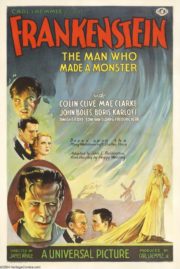Awakening Ancient Terrors
“Death… eternal punishment for anyone who opens this casket.” With these ominous words, The Mummy (1932) sets a chilling scene for its audience. Directed by the legendary Karl Freund, this pre-code horror film utilizes the mysticism of ancient Egypt to weave a tale of suspense and the supernatural. Unlike the blood-soaked revivals it would inspire decades later, the original The Mummy is a subtle horror movie, one that relies heavily on atmosphere and a slow build to unearth its scare tactics.
Whispers from the Shadows: Atmosphere and Tone
The atmosphere in The Mummy is a character in its own right, crafted meticulously through shadow-kissed corridors and a sense of lingering dread. There’s a pervasive stillness and seething undercurrent of tension that infects each frame, each long take of the titular Mummy’s expressionless face fueling the horror that the audience feels. Freund plays with suspense like a maestro, capitalizing on the audience’s imagination to evoke fear, allowing for the build-up of quiet terror to crescendo at pivotal moments.
Cinematic Nightmares: Cinematography and Visuals
The cinematography, in the hands of Freund, who also worked on Metropolis, conjures a visual symphony that leans heavily into the strengths of black-and-white film. The play of light and shadow creates an oppressive, claustrophobic world where the unreal feels unsettlingly close to reality. There are no fancy special effects to speak of by modern standards; instead, the film’s power lies in its restraint and the subtle application of makeup and practical visuals that stand the test of time.
Echoes of the Ancients: Soundtrack and Sound Effects
The soundtrack and sound effects creep just beneath one’s skin. There is a quiet eeriness to the film’s score that supports the narrative without ever threatening to overtake it. It’s in the silences, though, that the film often finds its most powerful voice—those moments of anticipation where you can almost hear your own heartbeat synchronize with that of the characters’.
Under the Wraps: Performances and Characters
The performances across the board are measured and effective. Boris Karloff’s turn as Imhotep/Ardath Bey is a standout, his presence radiating an uncanny blend of menace and sorrow. The characters feel both of their time and yet timeless, capturing the universal human reactions to fear—the desire to uncover the unknown, the recklessness of passion, and the inescapable grip of fate.
The Curse of Genre: Type and Techniques of Horror
As a forerunner in the canon of horror, The Mummy entails elements of psychological and supernatural terror. It defies jump scares or visceral gore, instead relying on a more cerebral approach that was quite innovative for its time. The film employs a slow-burn horror that gnaws at the psyche, peeking into the human fascination with mortality and the afterlife.
A Thriller Wrapped in Enigma: Themes and Societal Commentary
Underneath its thrilling exterior, The Mummy is also a splice of societal commentary, touching upon themes of colonialism, cultural appropriation, and the insidious nature of obsession. The film uses horror as a lens to magnify these deeper issues, which resonates even with contemporary audiences.
The Verdict from the Sarcophagus
In a time where gore and high-stakes CGI hauntings dominate the horror landscape, The Mummy (1932) serves as a reminder of the genre’s more understated origins. It is not merely a horror movie but a relic of cinematic craftsmanship that evokes fear through atmosphere and implication. While it might not provoke nightmares as more explicit fare might, it teases the imagination and unsettles the mind, marking it as a triumph in its own right.
Those with an appreciation for classic horror, atmospherics, and the cultural tapestry of 1930s filmmaking will find much to enjoy in The Mummy. Its pacing and subtler scares may not cater to the adrenaline-seeking horror junkie, but for the aficionado, it’s a must-see—a timeless piece that stands alongside greats like Dracula and Frankenstein.
Overall, The Mummy (1932) is a finely wrapped package of atmospheric tension and haunting performances. It may have its creaks and groans as an artifact of an earlier era of filmmaking, but within them lie the eternal whisperings of the horror genre’s beguiling roots. This movie comes highly recommended for those seeking to excavate the origins of cinematic chills but comes with the caution that it is more of a psychological haunt than a visual fest of horrors.




